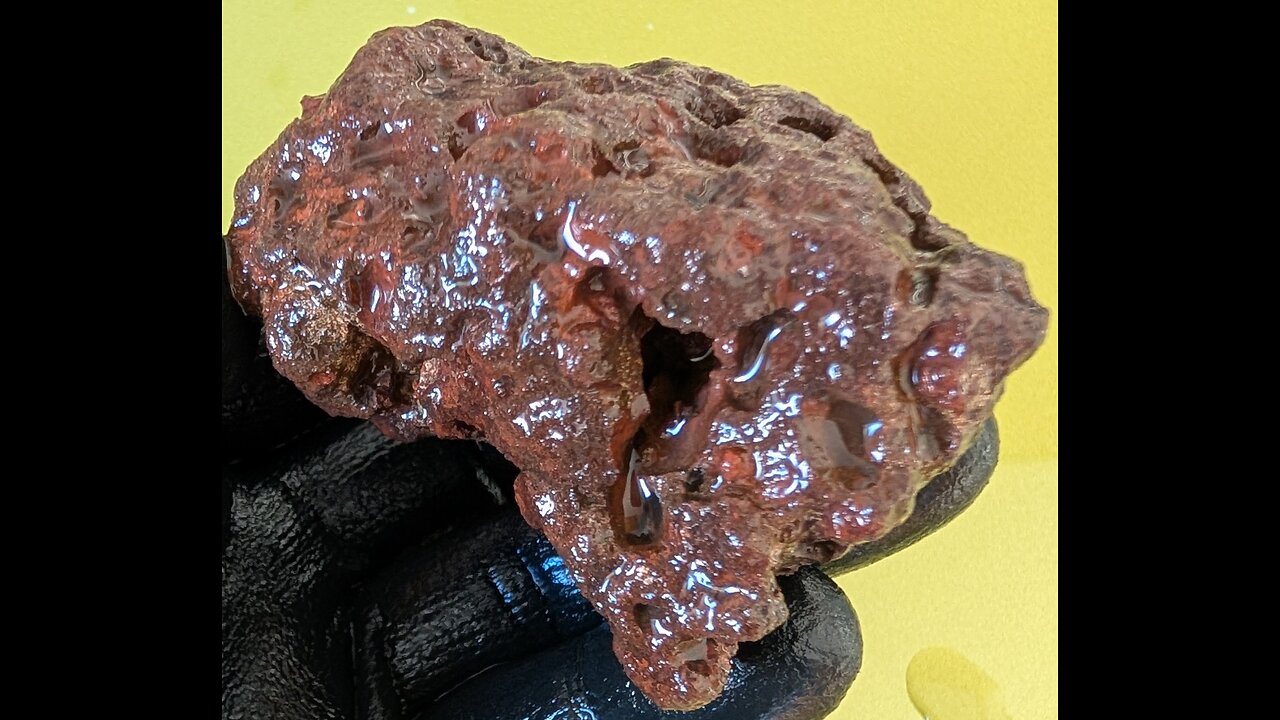Premium Only Content

Lava chunk!
Lava rock, often referred to simply as "lava," is a term commonly used to describe various types of igneous rocks that form from the cooling and solidification of molten lava on the Earth's surface. Here are some key details about lava rock:
Formation: Lava rock forms when magma, which is molten rock beneath the Earth's surface, erupts as lava during a volcanic eruption. Once exposed to the cooler temperatures at the surface, the lava cools and solidifies into rock.
Types of Lava Rock:
Basalt: The most common type of lava rock, formed from low-viscosity, mafic lava. It's dark, fine-grained, and can have a vesicular (full of small holes) texture if gas escapes during cooling.
Andesite: Intermediate in composition, often found in subduction zones. It's lighter in color than basalt and can have a porphyritic texture.
Rhyolite: Formed from high-viscosity, felsic lava, typically light in color with a fine-grained or glassy texture. It often forms during explosive eruptions.
Pumice: A very light, porous form of lava rock with a high gas content, which can float on water due to its low density.
Obsidian: A volcanic glass that forms when lava cools very rapidly, preventing crystal growth. It's usually black but can have other colors due to impurities.
Texture: The texture of lava rock varies widely:
Aphanitic: Fine-grained, where individual crystals are not visible to the naked eye due to rapid cooling.
Vesicular: Contains gas bubbles or vesicles, common in basalts and pumice.
Glassy: Like obsidian, where the rapid cooling prevents crystal formation.
Porphyritic: Contains larger crystals (phenocrysts) within a finer matrix, indicating a two-stage cooling process.
Color: The color can range from black or dark gray (basalt, obsidian) to light gray, pink, or even white (rhyolite, pumice), depending on the composition and cooling rate.
Uses:
Landscaping: Lava rock is often used in gardens for its aesthetic appeal and drainage properties.
Construction: Crushed lava rock can be used as aggregate in concrete or as a building material.
Art and Jewelry: Some types, like obsidian, are used in crafting jewelry or decorative items.
Abrasives: Pumice, due to its abrasive nature, is used in various cleaning and polishing applications.
Geological Significance: Lava rocks provide evidence of volcanic activity, helping geologists understand volcanic processes, the composition of the Earth's mantle, and the history of volcanic eruptions in a region. They are also studied for their role in soil formation and ecosystem development after volcanic events.
-
 10:18
10:18
Colion Noir
3 hours agoViral TikTok Proves Gun Owners Wrong?
22.3K28 -
 5:31
5:31
John Rich Official
13 days agoThe Righteous Hunter by John Rich
23.4K10 -
 59:51
59:51
Rebel News
3 hours agoEby threatens to block pipeline, Guilbeault out of cabinet, Land disputes continue | Rebel Roundup
24.7K4 -
 1:45:59
1:45:59
Robert Gouveia
5 hours agoAmerican Soldier DEAD! Trump Furious! Afghan 'Vetted by CIA'! Third World FREEZE!
48.9K36 -
 48:48
48:48
The Culture War with Tim Pool
4 hours agoThe West Is COLLAPSING Under Mass Migration | The Culture War's Across The Pond
35.7K66 -
 1:42:33
1:42:33
The Mel K Show
4 hours agoMORNINGS WITH MEL K - We Have Not Yet Begun to Fight - The Clock is Ticking! 11-28-25
29.3K14 -
 1:25:54
1:25:54
Film Threat
16 hours agoHOLLYWOOD FOR SALE! BLACK FRIDAY BLOW OUT! | Film Threat Livecast
17.4K2 -
 2:51:52
2:51:52
The Shannon Joy Show
5 hours agoSJ Show Nov 28 - The SJ Friday Matinee Watch Party With Commentary Featuring The Big Short!
16.8K -
 35:39
35:39
Grant Stinchfield
7 hours ago $2.67 earnedThe Medical Deep State Exposed — And McCullough Has the Receipts!
14K -
 59:15
59:15
Trumpet Daily
4 hours ago $3.45 earnedTrumpet Daily LIVE | Nov. 28, 2025
13.8K3